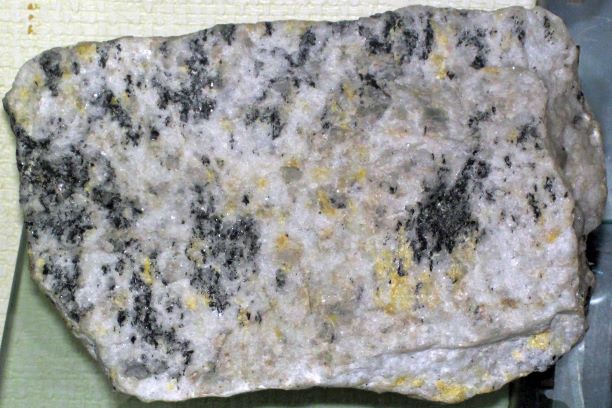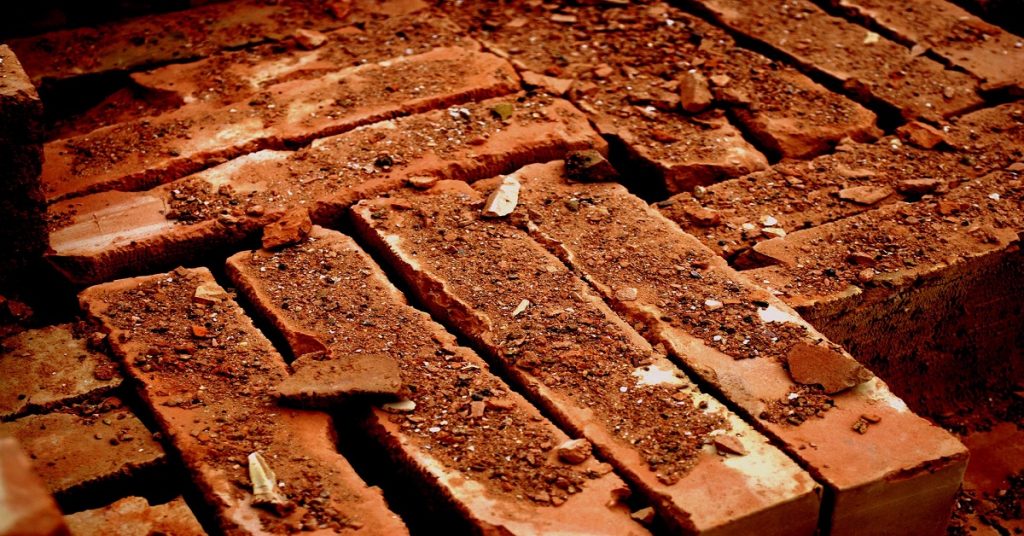Common Building Stones

The characteristics of some of the common stones serving the purpose of building construction are listed as follows:
Granite
Composition
- Granite is an igneous rock of siliceous nature.
- The solidification of magma at a considerable depth below the earth’s surface result in the formation of granite.
- Granite contains mostly mica, quartz and feldspar.
Characteristics
- It is hard and durable. But, it has low fire resistance and low water absorption.
- The colour of granite varies according to the amount of feldspar in it. The colour of granite varies from brown, grey, green, pink.
- Granite can take good polish.
- The compressive strength of granite is about 100 to 250 MPa.
- Its specific gravity lies between 2.60 to 2.70.
- Its density is about 26 to 27 KN/m3.
- Granite is expensive.


Use
- Granite is suitable for the construction of large engineering projects such as bridge abutments, dams, offshore structures, river walls etc.
- The construction of steps, walls, flooring, kerbs, pedestals etc., can be done using granite.
- Polished granites are preferred for table tops, cladding for walls and columns.
- Crushed granites are used as coarse aggregates in concrete and also as road metal and railway ballast.
- Large pieces of granite are used as building blocks.
- It can also be used as damp proof course.
Occurrence
- Granite is found in Maharashtra, Rajasthan, Uttar Pradesh, Madhya Pradesh, Punjab, Assam, Tamil Nadu, Karnataka and Kerala.
Marble
Composition
- Marble is formed form limestone on exposure to excessive heat.
- Marble is a metamorphic rock composed of calcite or dolomite crystals.
Characteristics
- Marble is available in different colours like white, yellow, grey, green, red, blue, black, pink.
- The compressive strength of marble varies from 70MPa to 75MPa.
- The specific gravity of marble is around 2.65.
- Marble stones are strong, compact, fine grained, uniform in texture and can take an excellent polish.

Uses
- Marble has an aesthetically pleasing appearance. So it is often chosen for faceworks, electrical switch boards, table slabs and ornamental works in columns, steps, stone facing slabs, flooring, etc.,
- It can be easily cut and carved into different shapes.
- Marble is most commonly used in bathrooms, spas, wall and floor tiles, etc.,
Occurrence
- White marble is found in Rajasthan (Jodhpur and Ajmer) and Madhya Pradesh (Jabalpur)
- Green marble is found in Gujarat (Baroda)
- Black marble is found in Rajasthan (Jaipur)
- Yellow marble is found in Rajasthan (Jaisalmer)
Limestone
Composition
- It is a sedimentary rock containing high percentage of calcium carbonate.
- It is formed from the remains of seaweeds and living organisms which are consolidated and cemented together.
Characteristics
- Limestone is available in different colours like brown, yellow, dark grey and violet.
- Limestone possess high resistance to corrosion and hence it is highly durable.
- The texture of limestone improves over time.
- The specific gravity of limestone is around 2.6.
- The crushing strength of limestone is around 50 MPa.
- Limestones are fine grained in nature.

Uses
- Limestone is a versatile rock and so it is used as a building material.
- It has high level of strength and hence it can be used as building blocks or bricks.
- Limestone is used for cladding on walls and for flooring.
- Limestone is also used a base material for cement.
- Limestones are used in blast furnaces, bleaching, tanning and other industries
- The use of limestones as facing stones must be avoided in areas where the air is polluted with industrial gases and also in coastal regions where winds carrying salt can cause deterioration.
Occurrence
- It is found in Maharashtra, Andhra Pradesh, Punjab, Himachal Pradesh, Bihar and Tamil Nadu.
Sandstone
Composition
- Sandstone is a sedimentary rock of siliceous nature. Hence, these rocks are stratified in nature.
- It is formed due to the mechanical disintegration of igneous rocks.
- Sandstone contains quartz and/or feldspar cemented by lime, mica, magnesium, aluminium, oxide or iron or by a mixture of these materials.
Characteristics
- Sandstone is available in different colours like white, grey, red, brown, yellow, pink and dark grey.
- The proportion of minerals present determine the hardness of sandstone.
- The compressive strength of sandstone is around 65 MPa.
- The specify gravity of sandstone is around 2.25.
- Porosity of sandstone varies from 5% to 25%.
- The nature of cementing material present defines the durability of sandstone. The quality of porous sandstone and sandstone containing lime or clay is poor.
- Sandstones are generally weak in abrasion.
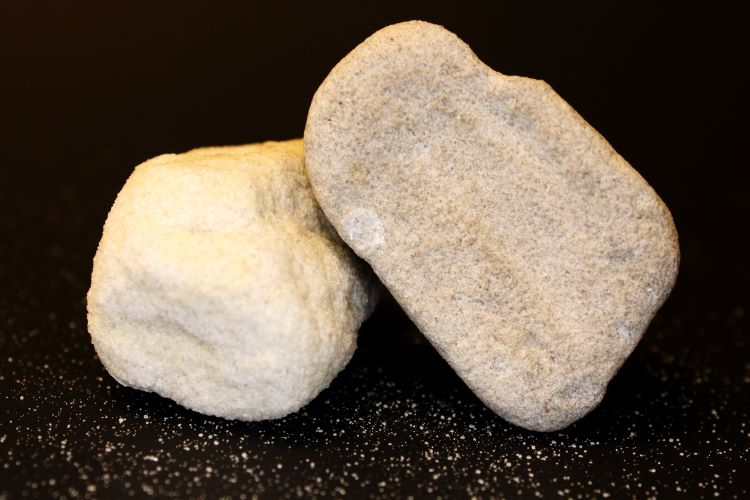
Uses
- Sandstone in combination with silica cement can be used in the construction of heavy structures.
- Sandstones are used for masonry works in dams, bridge piers, and river walls.
- Sandstone is susceptible to weathering and hence it is unsuitable for building construction.
- Fine grained stones are used for ashlar work, mouldings, carvings etc.
- Rough and coarse grained sandstones are used for rubble work, ornamental works, paving and for slabs and tiles.
Occurrence
- It is available in Madhya Pradesh, Rajasthan, Uttar Pradesh, Himachal Pradesh, Maharashtra and Tamil Nadu.
Gneiss
Composition
- It is a metamorphic rock formed from Granite. The minerals present in gneiss are the same as that of granite. Gneiss differs from granite only in structure.
- Gneiss exhibits foliated structure with alternate dark and white bands. Hence, these rocks can be split into thin slabs.
Characteristics
- Gneiss is available in grey, pink, purple colours.
- Gneiss is more readily workable than granite.
- The specific gravity of gneiss varies from 2.5 to 3.0.
- The crushing strength of Gneiss varies from 50 to 200 MPa.
- The presence of deleterious constituents makes the stone unsuitable for construction.
Uses
- Gneiss is used in minor constructions. However hard varieties may be used for the construction of buildings.
- Crushed gneiss is used for flooring, rough stone masonry works, pavement construction, stone pitching, etc.
- Due to the availability of various colours, gneiss is mostly used for ornamental and decorative purposes.
Occurrence
- It is found in Karnataka, Andhra Pradesh, Tamil Nadu and Gujarat.
Slate
Composition
- Slate is a metamorphic rock of argillaceous nature.
- It is formed from shale due to high pressure.
- It consists of quartz, mica, and clay minerals.
Characteristics
- The colour of slate varies from grey to black.
- It is fine grained in nature.
- They can be split easily along the planes of bedding.
- The properties of slate varies depending on the thickness of the sheets and colour of the rock.
- The compressive strength of slate ranges from 100MPa to 200MPa.
- Its specific gravity varies from 2.6 to 2.7.
- Slate is strong, weather resistant and has low water absorption.
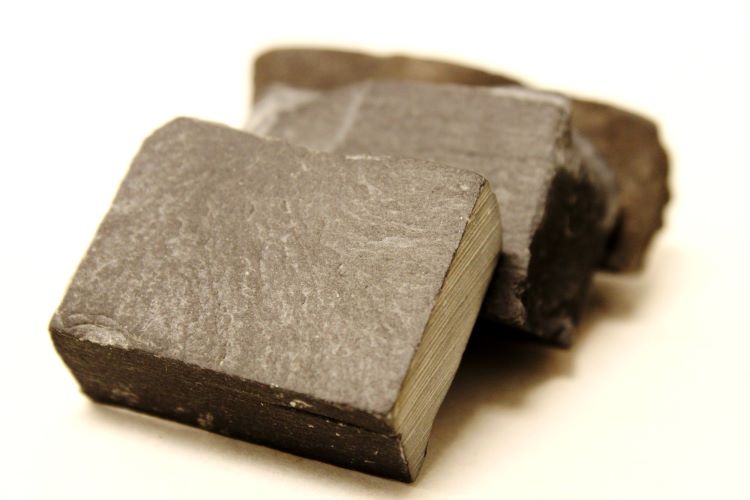
Occurrence
- Slate is found in Haryana, Punjab, Andhra Pradesh, Maharashtra, Madhya Pradesh, Rajasthan, Himachal Pradesh, Gujarat.
Use
- Slate is used as damp-proof course, flooring and roofing material.
- It is also used for pavements.
- It is useful for making electrical switch boards.
- Slate is suitable for use in cisterns, urinal partitions etc.
Quartzite
Composition
- It is a metamorphic rock formed from sandstone due to excess heat and pressure.
- It contains mostly of quartz; Mica and feldspar are present in small quantities.
Characteristics
- It is hard, brittle, crystalline and durable in nature.
- It is difficult to work with.
- Quartzite is available in different colours like white, grey, yellowish.
- The specific gravity of quartzite ranges from 2.55 to 2.65.
- Crushing strength of quartzite varies from 50 to 300 MPa.
- Quartzite is more resistant to stains.
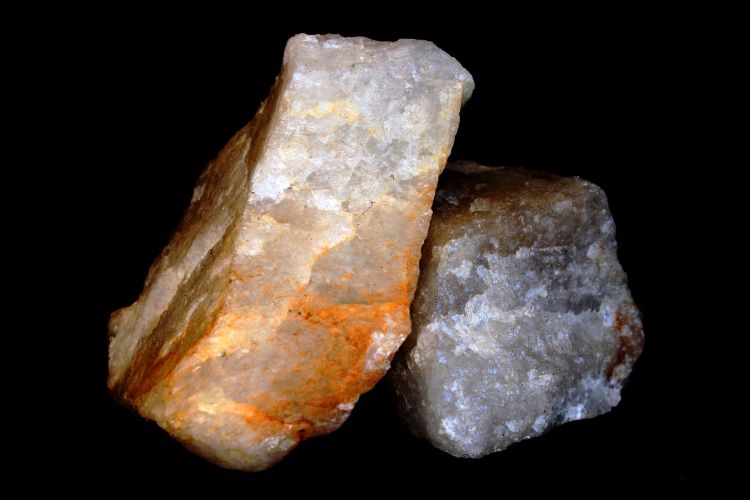
Uses
- They are used as slabs and building blocks.
- They are also used as aggregates for concrete, road metal and railway ballast.
- As quartzite is brittle, it is not used for ornamental works.
- It is also used for the production of industrial silica sand.
- It is also used in for heavy construction works like retaining walls, bridge piers, dams etc.
- Quartzite is also used for rubble masonry, stone pitching, etc.
Basalt and Trap
Composition
- Basalt and trap are igneous rocks of siliceous variety.
- The main ingredients are silica, alumina and feldspar.
Characteristics
- These are fine grained and compact.
- They are hard, tough and durable. Hence, it is difficult to work with these rocks.
- Basalt and trap possess good sound absorption and heat insulation properties.
- They are acid and alkali resistant.
- The colour of these stones varies from dark grey to black.
- The compressive strength of granite is about 200 to 350 MPa.
- Its specific gravity lies between 2.60 to 3.0.
Uses
- These stones are used in the manufacture of artificial stones.
- Basalt and traps are used in rubble masonry works for bridge piers, river walls and dams.
- Coloured basalt and trap are used for the construction of decorative features.
- Basalt and trap can be used as
- Railway ballast
- Aggregate in concrete
- Pavement material
Occurrence
- Basalt and trap is found in Madhya Pradesh, Bihar.
Travertine
Composition
- Travertine is a sedimentary rock.
- It is a type of limestone which is formed by the rapid precipitation of calcium carbonate.
Characteristics
- The colour of travertine from grey to coral-red.
- It is characterized by holes and troughs in its surface. This indicates that it has a porous surface and concentric texture.
- Its specific gravity is 1.68.
- The compressive strength of travertine varies from 80 to 120 MPa.
- It can be polished to obtain smooth, shiny finish.
- It is easily affected even by weak acids.
Use
- It is used for pavements, garden paths and courtyards.
- Travertine resembles marble and can be used for flooring, wall cladding, etc.,
Kankar or Caliche
Composition
- It is a type of limestone containing 30 percent of clay and sand.
Characteristics
- Kankar is available in grey or khaki colour.
- It has porous structure.
- It occurs in solid layers or as irregular shaped modules below the earth surface.
- Hard kankar is adequately durable.
Uses
- On burning, nodular kankar yields excellent hydraulic lime.
- Clean, hard and tough nodular kankar is used as road metal.
- Hard kankar is used for the construction of foundations for buildings.
Chalk
Composition
- Chalk is a sedimentary rock and it contains pure limestone.
Characteristics
- It is white in colour.
- The structure of chalk is porous.
- It is soft and hence can be powdered easily.
Use
- It is used for manufacture of Portland cement and is also used as a colouring pigment in the manufacture of Portland cement.
- Chalk is also used for manufacturing lime putty.
- It is unsuitable for building purposes.
Shingles
- Shingles are large water-worn pebbles.
- These are found in river beds.
- Broken shingles are used as road metal or railway ballast or in concrete as aggregates.
Moorum
- It is a decomposed laterite.
- Moorum is of deep brown or red colour.
- It is used for making fancy paths and garden walks (due to its rich red colour).
- It is found in some parts of Madhya Pradesh.
Syenite
- Syenite is an igneous rock.
- It is hard and durable like granite.
- Syenite possess coarse-grained structure.
- Its crushing strength varies from 90 to 150 MPa.
- Crushed syenite is used as coarse aggregate for pavement construction and in concrete.
- It is also used for external facings of building walls etc.
